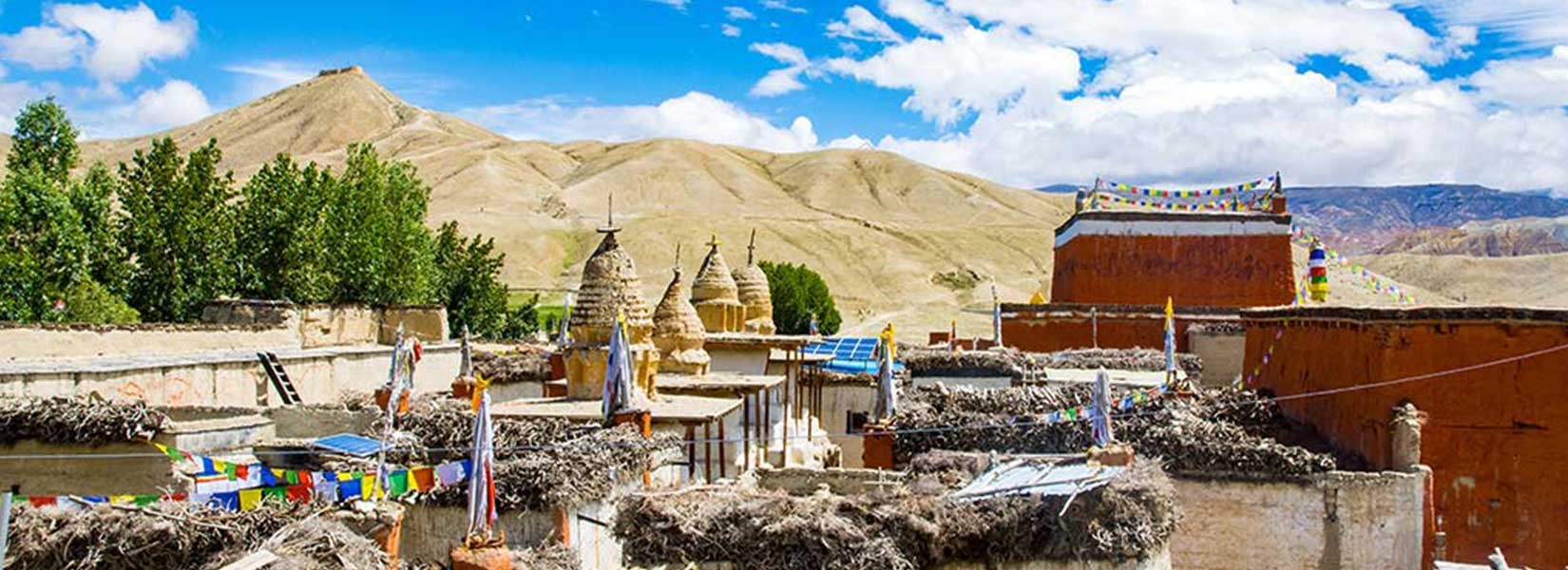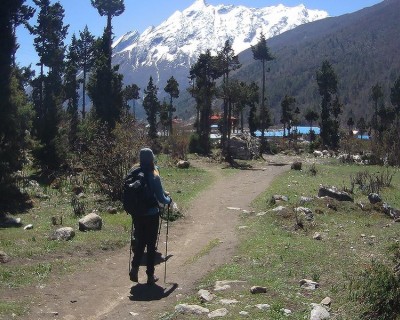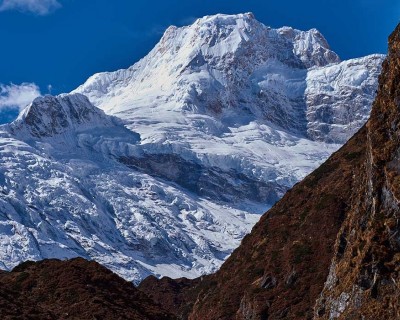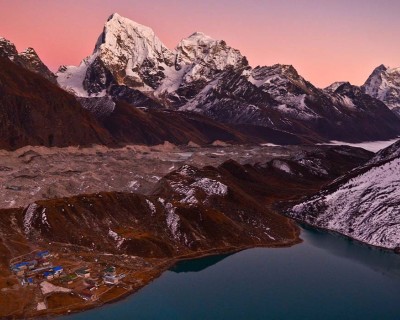Tucked behind the grandeur of Annapurna and Dhaulagiri lies a landscape that only a few travelers get to experience. It is known as the mystical realm of Upper Mustang. This high-Himalayan settlement of the Annapurna region is also referred to as “The Last Forbidden Kingdom”. Once a restricted territory, Upper Mustang remained closed to foreigners until 1992.
Thus, it has been able to successfully preserve its ancient Tibetan-influenced culture, stark desert topography and medieval walled towns like Lo Manthang. Here, the Himalayan shadows cast long over arid cliffs and labyrinthine caves. The centuries-old monasteries echo with chants that are carried by the dry mountain wind.
But this isn’t a region where you can show up anytime. That’s why it is crucial to understand the best time to visit Upper Mustang. It isn’t just for convenience it is crucial for both safety and enjoyment. Upper Mustang’s high elevation and limited infrastructure mean that weather conditions and seasonal accessibility significantly impact your experience.
Yes, it is true that Upper Mustang’s unique rain-shadow location makes it one of the few places in the country that you can visit even during monsoon. However, that still automatically doesn’t make every month ideal for this trek.
So, when is the best time to go? In terms of weather cultural vibrancy and trail conditions, the most favorable periods are spring (March to May) and autumn (September to November). These seasons offer crystal-clear skies, moderate temperatures and immersive cultural festivals.
Still, depending on your goals, solitude, photography, or offbeat exploration, you might find other months with their own subtle appeal.
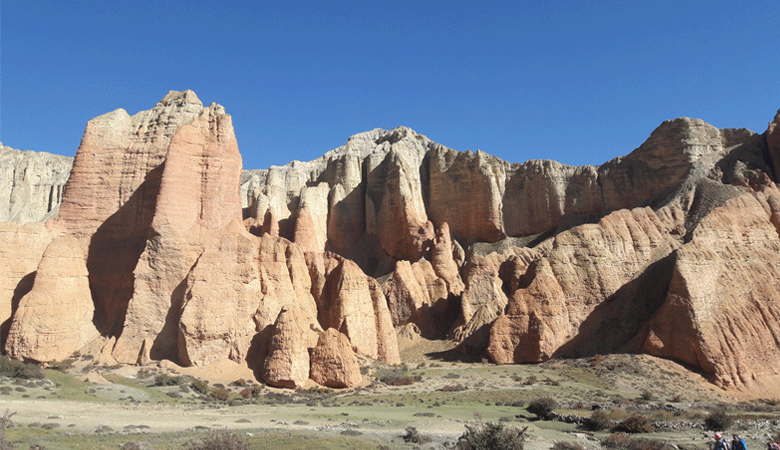
Understanding Upper Mustang’s Unique Geography and Climate
To understand the best time to visit Upper Mustang, you will need to first grasp the region’s distinct geography and microclimate. These factors set the Upper Mustang apart from almost every other trekking destination of the Himalayas.
- Rain Shadow of the Himalayas: The Upper Mustang region lies in the trans-Himalayan region on the northern side of the main Himalayan crest. This location places it in the rain shadow region. Meaning, it receives very little precipitation even during the monsoon season. In the core part of the monsoon, most of Nepal’s trekking routes are drenched by heavy rains. However, Upper Mustang remains mostly dry, making it a rare expectation.
- High Elevation and Desert Terrain: The elevation of Upper Mustang is approximately 4,000 meters (13,123 feet). The highest settlement of this trek is Lo Manthang which is at an altitude of 3,850 meters (12,631 feet). It is siuated near the Tibetan border. This altitude influences temperature extremes. Warm and sunny days can quickly give way to biting cold nights. The terrain itself is dry, windy and exposed. So, strong afternoon winds are common in the Kali Gandaki Valley.
- Seasonal Impact on Accessibility and Experience:
- During spring and autumn, the skies are usually crisp and clear. You will have ample opportunities ideal for photography and mountain views. As for monsoon, dust and haze can reduce visibility, especially in the lower elevations.
- Trail conditions during peak season are dry and easy to traverse. In winter, snow and icy paths can make trekking dangerous. In case of monsoon, trails are generally dusty (not muddy). But, flight disruption due to cloud cover in Pokhara can delay scheduled flights.
- The autumn season sees bustling village life with post-harvest celebrations. Meanwhile, spring offers the opportunity to witness the Tiji Festival, a sacred three-day ritual featuring masked dances and religious ceremonies in Lo Manthang. Winter, by contrast, is quiet and many locals migrate to lower altitudes. So, lodges at higher elevations shut down.
- Most teahouses, guides and transport services operate between April and November. In winter, much of the Upper Mustang falls into semi-hibernation. You will need to arrange for full support (porters, tents, kitchen tools, etc) by yourself. So, the winter exploration can be logistically more demanding and costly.
Best Time to Visit Upper Mustang
Yes, Upper Mustang’s rain-shadow location allows trekkers to explore the region even in months when much of Nepal is drenched or is snowbound. However, two seasons still stand out as undeniably the most favorable period, spring (April to June) and autumn (September to November). These periods offer the best combination of weather, trail conditions, cultural access and scenic grandeur.
Spring (April to May)
The spring season brings a sense of quiet renewal to the Upper Mustang. As the region gradually awakens from its winter stillness trekkers are greeted with plesantry. The temperatures are comfortable, the weather is dry and there is an upsurge in local activity.
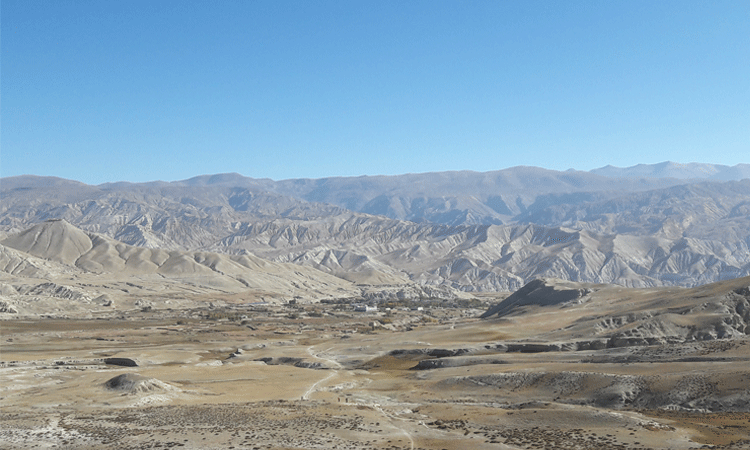
What Makes Spring Ideal?
- Stable Weather: The months from April to June have stable climate. Skies remain mostly clear with minimal precipitation. And temperatures range around 10°C to 20°C during the daytime in villages like Lo Manthang. However, it can dip below the freezing point at higher elevations. But, it is still far more manageable than the winter.
- Longer Daylight Hours: The sunrise in spring is generally around 5:30 to 6:00 A.M. and sunset is near 6:30 to 7:00 P.M. This will allow ample time to enjoy the exploration at your own pace. You don’t need to rush yourself and take your time to soak in the vibrant culture and atmosphere.
- Subtle Natural Beauty: The Upper Mustang doesn’t boast the dense rhododendron blooms like the Annapurna and Everest regions. However you will still be able to witness the alpine blossoms such as edelweiss, wild poppies and desert wildflowers. These alpine flora cover the arid trail and riverbanks, especially in month of May.
- Cultural Highlight: One of the most compelling reasons to trek Upper Mustang in spring is the opportunity to witness the Tiji Festival. This is an incredible three-day Buddhist celebration held in Lo Manthang. As the festival is based on the lunar calendar, this event typically falls in mid to late May.
Perfect For:
- Travelers seeking cultural immersion
- Trekkers who prefer mild weather and dry trails
- Photographer and documentarian interested in vibrant festivals and dramatic landscapes
- Beginner trekkers who don’t want to deal with an extra set of weather challenges
Things to Consider:
- Afternoon Winds: During the mid-part of the spring season the strong katabatic winds are the daily feature of the high-altitude arid landscape. It is especially so in the Kali Gandaki Valley. The high wind usually picks up after 11 A.M., thus, making an early morning start is advisable. These winds are part of natural microlimate, They are dry and dusty but manageable with proper gear.
- Advance Booking for Tiji: The Tiji festival attracts a growing number of international trekkers and photographers. Lodges in Lo Manthang can get fully booked weeks in advance. If you are planning your trip around the festival, it is wise to reserve accommodation and permits well ahead of time.
Autumn (September to November)
Autumn is widely considered the prime season for trekking in Nepal. Upper Mustang Trek is no exception. The post-monsoon clarity transforms the landscapes into a dramatic canvas. The horizons are razor sharp, landscape features captivating hues of gold and the skies are cobalt.
What Makes Autumn Ideal?
- Post-Monsoon Cleanliness: By the middle part of September, the monsoon rains clear away dust and haze from the lower Annapurna valleys. Although Upper Mustang receives little rain, this cleansing effect on the entire region results in breathtaking crisp visibility. This season is ideal for viewing distant peaks, vast plateaus and ancient settlements with picture-perfect definition.
- Perfect Trekking Weather: The daytime temperatures in Upper Mustang during autumn typically range around 12°C to 22°C. The atmosphere is comfortable and energizing. Nights are cooler, but not yet biting cold. Similarly, the low humidity makes breathing at higher altitudes more tolerable than in the monsoon season.
- Cultural Vibrancy After Harvest: The Autumn season marks the end of the harvest season. Fields of barley and buckwheat have turned golden and villages are more relaxed. They are engaged in social gatherings and religious rituals. This makes a wonderful time for travelers who are interested in everyday life and quiet cultural observations. Some of the biggest festivals in the country like Dashain and Tihar also take place at this point.
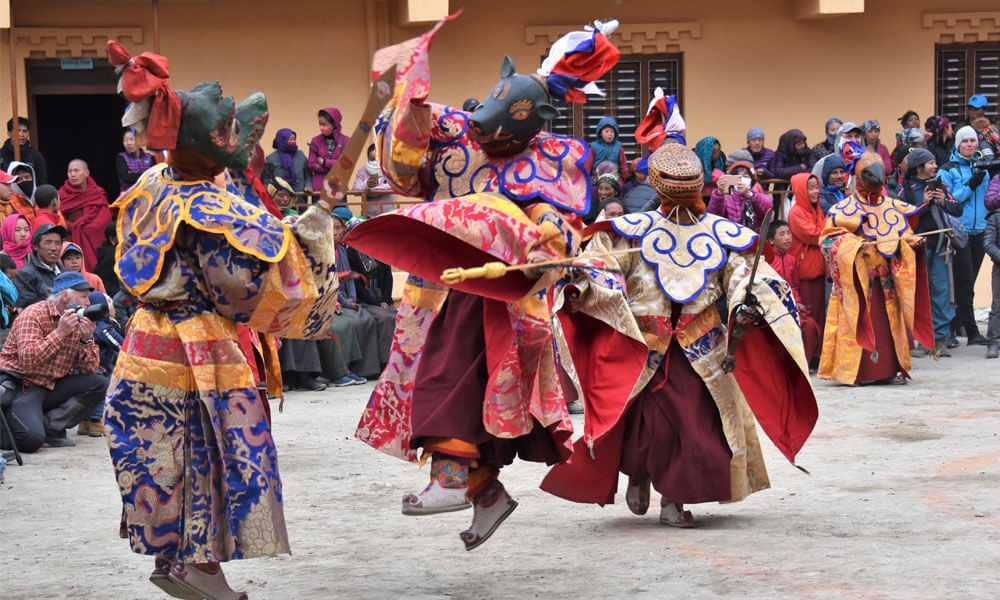
Perfect For:
- Trekkers focused on scenic exploration and clarity
- First-time trekkers who are seeking balanced conditions
- Hikers who prefer dry and accessible trails
- Cultural travelers seeking authentic village life
Things to Consider:
- Slightly Higher Visitor Volume: Although the Upper Mustang remains far less crowded than the Everest or Annapurna regions autumn is still most popular trekking period in country. You should expect a modest increase in trail activity and limited lodge space along the key spaces like Ghami and Lo Manthang. The crowd level reaches a pinnacle point, especially in October, which is the busiest month.
- Temperature Drop in Late Autumn: By early November temperatures start to drop quickly in the Upper Mustang region, particularly at night. If you are traveling in the latter part of November you need to pack accordingly for freezing conditions at higher elevations.
Takeaway: Together, spring and autumn seasons offer reliable weather, rich cultural events and spectacular scenery. This makes them the undisputed best time to visit Upper Mustang. If you want to witness sacred festivals, enjoy gentle trekking conditions, or photograph windswept canyons under clear skies, these windows across the year provide the most rewarding and memorable experience.
Visiting During the Off-Season: Should You? (An Honest Breakdown)
Upper Mustang’s unique trans-Himalayan geography allows for greater flexibility than other trekking regions. Thus, although off-season travel (winter and monsoon) is possible, it comes with significant trade-offs. Some adventurous travelers choose these months for solitude or logistics. But, it is important to know what to expect and plan with awareness of the challenges.
Monsoon (June to August)
Let’s be honest here. Monsoon is not an ideal season, especially for first-time visitors. Trekkers need to overcome several weather phenomena and need to have extra flexibility. Despite being sheltered from the full force of monsoon by the Annapurna and Dhaulagiri ranges, Upper Mustang isn’t completely unaffected. It remains drier than southern and central Nepal, which makes it an alternative during summer. However, there are still limitations.
Why Some Trekkers Still Choose Monsoon?
- Rain Shadow Advantage: Upper Mustang receives as little as 250 to 400 mm of rain annually. Compared to that, Pokhara receives about 1,400 to 1,800 mm of rain per year. This means that the trails remain accessible when regions like Everest Base Camp and Annapurna Circuit are washed out.
- Summer Accessibility: Some trekking agencies continue organizing treks during this time and the region still remains officially open. Thus you might find discount packages or more flexible schedules due to lower demand.
- Vibrant Himalayan Flora and Green Contrasts: While it's mostly arid the monsoon does add a surprising touch of color. Grasses start to sprout in meadows and riverbanks become greenery. This rare contrast of greenery against Musta’s ochre cliffs offers a unique photographic palette.
Challenges and Realities:
- Flight Disruption: Even if Jomsom remains dry, weather in Pokhara and Kathmandu often causes flight delays or cancellations. Cloud covers the sky and there is the probability of atoms and winds. This makes the domestic air travel unreliable, especially in July and August.
- Reduced Visibility: While summer rain is minimal, airborne dust and haze increase due to wind and dry soil. You will need to tackle this issue, especially in the Kali Gandaki corridor. As a result the dramatic landscape may appear muted and instant mountain views can be obscured.
- Leeches and Landslides on the Way Up: If you are trekking from lower areas (i.e., Kagbenin via Jomsom), some sections before the Upper Mustang are prone to leeches and minor landslides in monsoon, even if the higher Mustang region is dry.
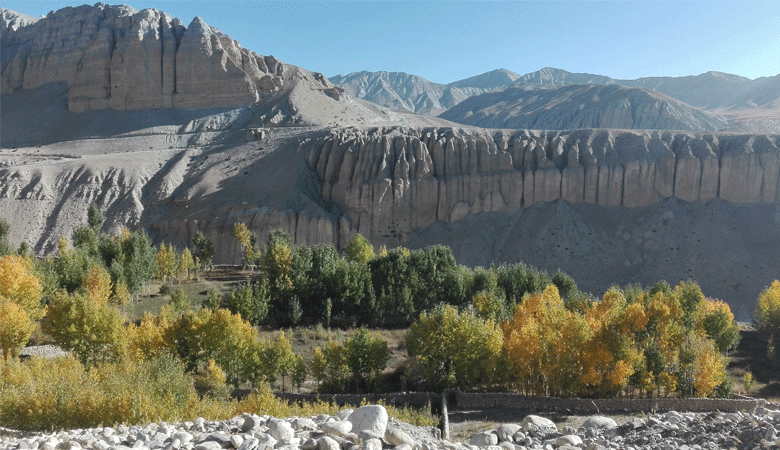
Ideal for:
- Travelers who are seeking to avoid crowds completely
- Repeat trekkers who understand the terrain
- The photographer focused on village life and daily rituals
- Travelers needing flexibility who value slow-travel journeys
Winter (December to February)
Winter trek, which is not most feasible in other regions, can be completed by a prepared and experienced trekker in the Upper Mustang region. Upper Mustang in the winter becomes a frozen desert. Though the snowfall is usually light, temperatures plummet dramatically. And, the infrastructure begins to close. Most locals at higher elevations descend to the lower part or relocate to the cities. This leads to a near-deserted atmosphere in places like Lo Manthang.
Why Winter Trek is Generally Not Recommended?
- Harsh Cold: The daytime temperatures of the Upper Mustang can stay below 5°C and the nighttime temperatures can often plunge to -15°Cor colder. This is especially the case during the core part of the winter, January. The high-altitude winds make the chill even more biting.
- Lack of Services: Most teahouses, shops and lodges in remote villages shut down completely by mid-December. Water resources may freeze and only the most basic shelter option remains. Thus, trekking in this season usually requires a fully supported camping crew or pre-arranged private accommodations.
- Accessibility Issues: Snowfall can sometimes block trails or passes leading to and from Mustang, even if the interior is dry. Flights to Jomsom may be irregular due to winter fog in Pokhara. So, even if there isn’t a complete blockage like monsoon, you need to be flexible with the accessibility complications.
Only Suitable For:
- Seasoned, self-sufficient trekkers with winter trekking gear
- Travelers with a full support team (guide, cook, porters, etc)
- Those deliberately seeking solitude, stark beauty and challenges
- Expedition-style travelers
- People with contingency time and no hard deadlines
Risk to Consider:
- Increased risk of altitude-related sickness as cold exacerbates the symptoms and restricts the recovery options
- Limited daylight hours, which shorten the trekking windows
- Wildlife encounter, rare but potentially dangerous if alone or unprepared
- Possible loss of trail signage or landmarks due to snow coverage
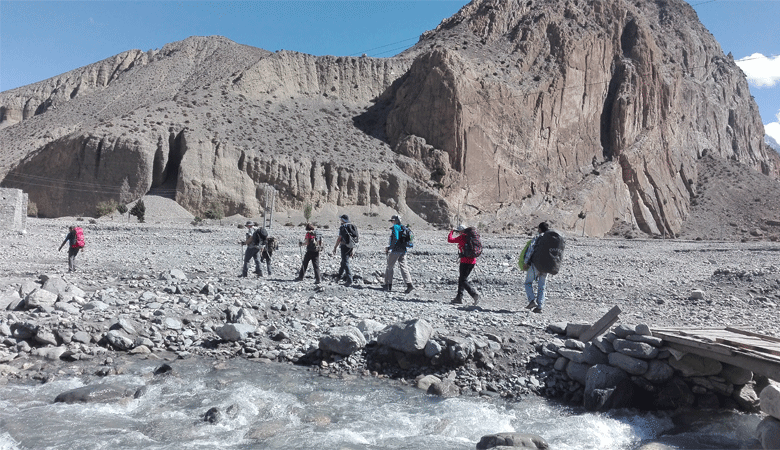
Final Say
The Upper Mustang Trek is a rare passage into the lost world of the Himalayas with wind-swept valleys, ochre cliffs and timeless Tibetan culture. But the magic of this journey depends heavily on when you decide to explore it. For most travelers spring (April to June) and autumn (September to November) offer the perfect balance.
These peak travel seasons have clear skies, comfortable temperatures, open teahouses and cultural vibrancy. Thus, they promise the best experience for first-time visitors, photographers and trekkers seeking both comfort and depth. However, for those who are drawn to quietude, challenge, or the unique perspective of the Himalayas, winter and monsoon hold their own subtle allure.
But only if you are prepared. These off-peak months may reward you with the rare moments that no guidebook can promise. So, in overall, ultimately, the best time to visit Upper Mustang isn’t just about weather, it is also about your purpose. Whether you chase festivals, scenery, landscape, or unforgettable stories, there’s a window that matches your journey.



